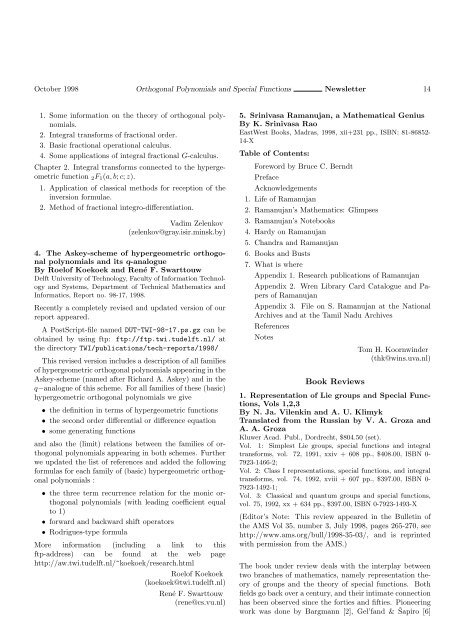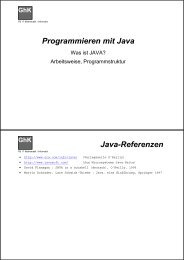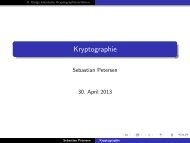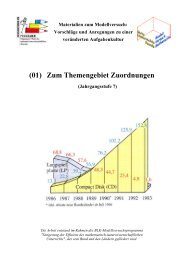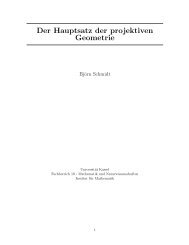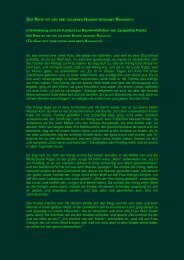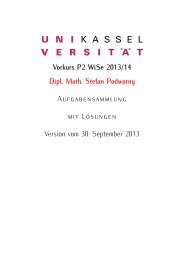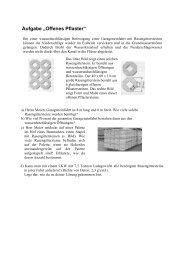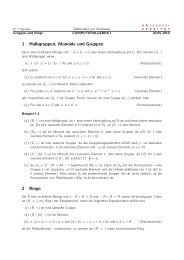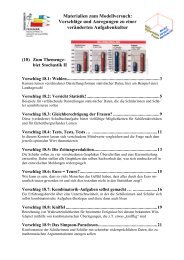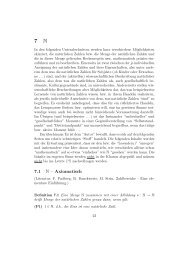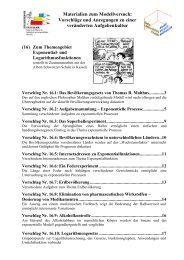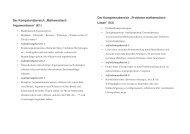Orthogonal Polynomials and Special Functions
Orthogonal Polynomials and Special Functions
Orthogonal Polynomials and Special Functions
You also want an ePaper? Increase the reach of your titles
YUMPU automatically turns print PDFs into web optimized ePapers that Google loves.
October 1998 <strong>Orthogonal</strong> <strong>Polynomials</strong> <strong>and</strong> <strong>Special</strong> <strong>Functions</strong> Newsletter 14<br />
1. Some information on the theory of orthogonal polynomials.<br />
2. Integral transforms of fractional order.<br />
3. Basic fractional operational calculus.<br />
4. Some applications of integral fractional G-calculus.<br />
Chapter 2. Integral transforms connected to the hypergeometric<br />
function 2F1(a, b; c; z).<br />
1. Application of classical methods for reception of the<br />
inversion formulae.<br />
2. Method of fractional integro-differentiation.<br />
Vadim Zelenkov<br />
(zelenkov@gray.isir.minsk.by)<br />
4. The Askey-scheme of hypergeometric orthogonal<br />
polynomials <strong>and</strong> its q-analogue<br />
By Roelof Koekoek <strong>and</strong> René F. Swarttouw<br />
Delft University of Technology, Faculty of Information Technology<br />
<strong>and</strong> Systems, Department of Technical Mathematics <strong>and</strong><br />
Informatics, Report no. 98-17, 1998.<br />
Recently a completely revised <strong>and</strong> updated version of our<br />
report appeared.<br />
A PostScript-file named DUT-TWI-98-17.ps.gz can be<br />
obtained by using ftp: ftp://ftp.twi.tudelft.nl/ at<br />
the directory TWI/publications/tech-reports/1998/<br />
This revised version includes a description of all families<br />
of hypergeometric orthogonal polynomials appearing in the<br />
Askey-scheme (named after Richard A. Askey) <strong>and</strong> in the<br />
q−analogue of this scheme. For all families of these (basic)<br />
hypergeometric orthogonal polynomials we give<br />
• the definition in terms of hypergeometric functions<br />
• the second order differential or difference equation<br />
• some generating functions<br />
<strong>and</strong> also the (limit) relations between the families of orthogonal<br />
polynomials appearing in both schemes. Further<br />
we updated the list of references <strong>and</strong> added the following<br />
formulas for each family of (basic) hypergeometric orthogonal<br />
polynomials :<br />
• the three term recurrence relation for the monic orthogonal<br />
polynomials (with leading coefficient equal<br />
to 1)<br />
• forward <strong>and</strong> backward shift operators<br />
• Rodrigues-type formula<br />
More information (including a link to this<br />
ftp-address) can be found at the web page<br />
http://aw.twi.tudelft.nl/~koekoek/research.html<br />
Roelof Koekoek<br />
(koekoek@twi.tudelft.nl)<br />
René F. Swarttouw<br />
(rene@cs.vu.nl)<br />
5. Srinivasa Ramanujan, a Mathematical Genius<br />
By K. Srinivasa Rao<br />
EastWest Books, Madras, 1998, xii+231 pp., ISBN: 81-86852-<br />
14-X<br />
Table of Contents:<br />
Foreword by Bruce C. Berndt<br />
Preface<br />
Acknowledgements<br />
1. Life of Ramanujan<br />
2. Ramanujan’s Mathematics: Glimpses<br />
3. Ramanujan’s Notebooks<br />
4. Hardy on Ramanujan<br />
5. Ch<strong>and</strong>ra <strong>and</strong> Ramanujan<br />
6. Books <strong>and</strong> Busts<br />
7. What is where<br />
Appendix 1. Research publications of Ramanujan<br />
Appendix 2. Wren Library Card Catalogue <strong>and</strong> Papers<br />
of Ramanujan<br />
Appendix 3. File on S. Ramanujan at the National<br />
Archives <strong>and</strong> at the Tamil Nadu Archives<br />
References<br />
Notes<br />
Book Reviews<br />
Tom H. Koornwinder<br />
(thk@wins.uva.nl)<br />
1. Representation of Lie groups <strong>and</strong> <strong>Special</strong> <strong>Functions</strong>,<br />
Vols 1,2,3<br />
By N. Ja. Vilenkin <strong>and</strong> A. U. Klimyk<br />
Translated from the Russian by V. A. Groza <strong>and</strong><br />
A. A. Groza<br />
Kluwer Acad. Publ., Dordrecht, $804.50 (set).<br />
Vol. 1: Simplest Lie groups, special functions <strong>and</strong> integral<br />
transforms, vol. 72, 1991, xxiv + 608 pp., $408.00, ISBN 0-<br />
7923-1466-2;<br />
Vol. 2: Class I representations, special functions, <strong>and</strong> integral<br />
transforms, vol. 74, 1992, xviii + 607 pp., $397.00, ISBN 0-<br />
7923-1492-1;<br />
Vol. 3: Classical <strong>and</strong> quantum groups <strong>and</strong> special functions,<br />
vol. 75, 1992, xx + 634 pp., $397.00, ISBN 0-7923-1493-X<br />
(Editor’s Note: This review appeared in the Bulletin of<br />
the AMS Vol 35, number 3, July 1998, pages 265-270, see<br />
http://www.ams.org/bull/1998-35-03/, <strong>and</strong> is reprinted<br />
with permission from the AMS.)<br />
The book under review deals with the interplay between<br />
two branches of mathematics, namely representation theory<br />
of groups <strong>and</strong> the theory of special functions. Both<br />
fields go back over a century, <strong>and</strong> their intimate connection<br />
has been observed since the forties <strong>and</strong> fifties. Pioneering<br />
work was done by Bargmann [2], Gel’f<strong>and</strong> & ˇ Sapiro [6]


